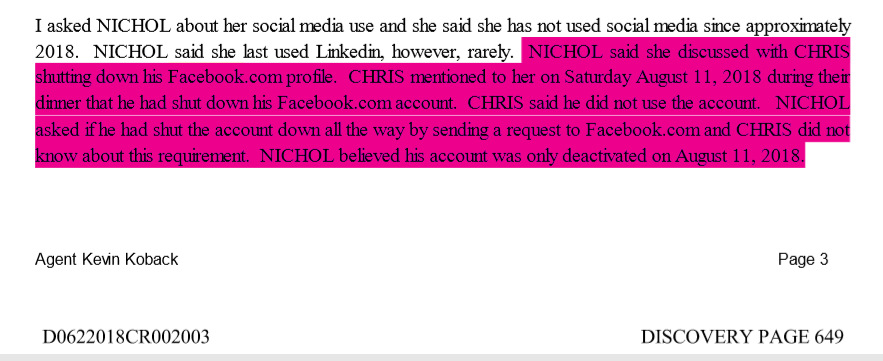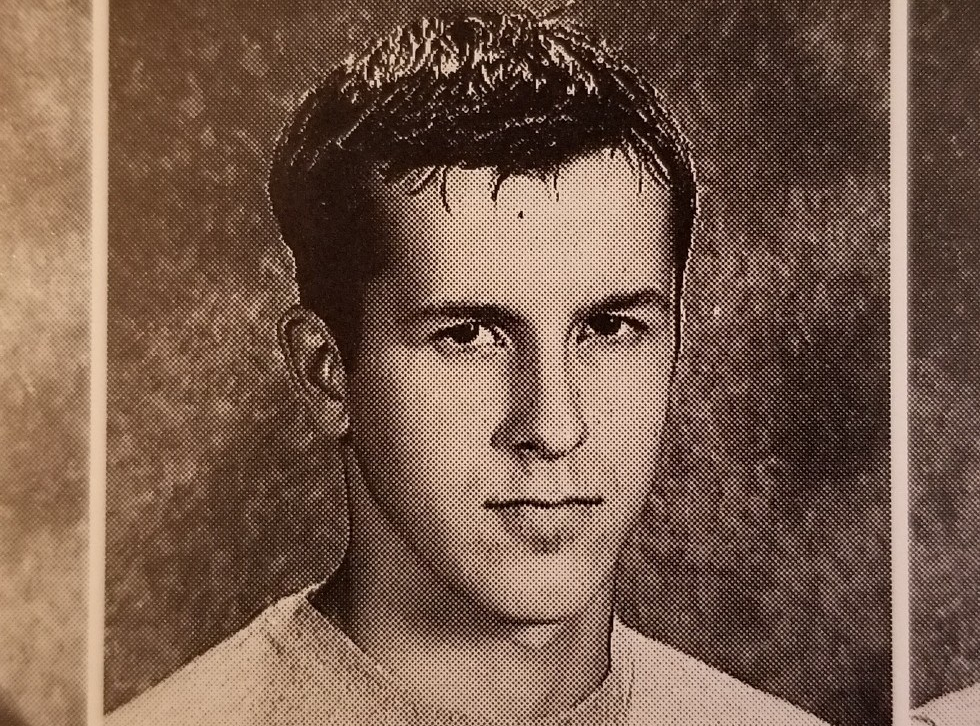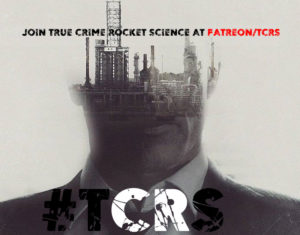Is this it?

True Crime Analysis, Breakthroughs, Insights & Discussions Hosted by Bestselling Author Nick van der Leek
Tag: Chris Watts (Page 11 of 47)
There was a second gay man who claimed to have a relationship with Chris Watts [well, except there wasn't]
According to the Daily Mail, there’s a second gay fella who claimed to have met Chris Watts in rehab. The Daily Mail is so brazenly confident in this assertion, they have the allegation in their headline.

A second gay dude would certainly add fuel to the bisexual fire, except that the Daily Mail have gotten their lines crossed. Chris Watts was never in rehab, Trent Bolte was. Uh-oh, it looks like some journalists and editors haven’t done their homework…


But this line of inquiry, though not as sensational as the Daily Mail would have us believe, isn’t a complete waste of time. Have a look at this snippet from the article.

Interesting, isn’t it, that Watts knew that detail? It suggests he’s taken a keen interest in what’s been said or written about him. Now why would that be…?
The mainstream media, and most [but not all] covering the Chris Watts case on YouTube are referring to big chunks of Watts’ Second Confession as if it’s fact. When CNN’s headline [on Google Search] reads Chris Watts’ 4-year-old pleaded for her life, attorney says it reads as fact.
When People report on Bella’s “last words” – ‘Daddy, No!’: Chris Watts Hears Daughter’s Haunting Last Words ‘Every Day’ in Prison – and Dr. Phil does a show PREMISED on these last words [words Watts’ tells us are her last words – and enough in media and on social media recycle this premise, then it begins to appear as fact.

Is it fact?
We must remember this hasn’t been tested, examined, argued or verified in court. A judge and jury haven’t ruled on it, or even thought about it. Evidence hasn’t been led in the proper forum in support or to contradict it. And let’s be clear, a Dr. Phil show or a confession from a man who murdered his family, lied to that family, lied to his witness, lied to the media, lied on a polygraph test [about everything], and lied throughout his first “confession” including to his own father, this hardly constitutes evidence. It’s testimony. It’s a version. That’s all it is.
But what if it is true? And what if there is convincing evidence to prove that it is?
Isn’t there convincing evidence in the “living shadows” conspiracy? Was the conspiracy never a conspiracy at all, instead civilians and armchair detectives stumbled on a game changer that law enforcement [and everyone else] missed?
If this is the case why hasn’t the mainstream media reported on the shadow theories? If it’s such a game changer, why hasn’t the media said anything about it? Why hasn’t law enforcement released a statement?
On the one hand, Weld County District Attorney Michael Rourke has referred to this as part of his contention, his assumption, that Watts’ confession is legitimate, or mostly truthful. According to USAToday:
Rourke said some pieces of evidence match Watts’ most recent confession, including footage from a neighbor’s security camera that shows another shadow aside from Watts’ by his truck when he was loading Shanann’s body into the back seat.
In the video released by the Weld County District Attorney’s Office, Watts is seen standing by his work truck when another shadow appears to be moving toward him, and Watts leans down to pick something up, likely one of the girls.
That video “would be consistent with his statements that the girls were alive when they left the house and walked out to the truck,” Rourke said.
What Rourke is saying is that Watts’ statement is consistent with the “appearance” of a shadow which doesn’t seem to be Watts’ moving towards him. Separately Rourke says, “I’m assuming what he is telling is truthful”, which suggests he believes the shadow theory as well. But he doesn’t say that. He says the scenario is consistent with the appearance of the shadows.

The article goes on to emphasize that Watts has never testified under oath, with the threat of perjury. In other words, whenever he’s spoken – other than the polygraph test where he had to authorize it – there haven’t been legal consequences – arguably, attached to his spoken words, as crazy as that sounds. And Rourke has maintained, even after the Second Confession Watts’ consistency in another area – his lack of real remorse:
“I don’t think that everything that came out of his mouth during those interviews was the truth because I honestly don’t believe that this monster has the ability to have remorse at all.”
None of the bold text [referring to the commission of the murders of Shan’ann and the children respectively] resonated with me, although certain aspects certainly stood out [such as Shan’ann feet thudding on the stairs]. What did stand out for me was this, and it comes at very end of the marathon interview. When I heard Watts’ answer, for the first time I considered the scenario of the children alive and taken to CERVI 319 as a real possibility.

The area circle in red can be heard at 1:05:39 in the last half hour of the five-and-a-half-hour interview [Part 2 of the Enhanced Audio Clip].
LEE: So do you think if we would have said…what do you think…?
Lee is asking what should they have said to him that would have gotten Watts to tell the truth, or do so sooner.
WATTS [Long pause]: If you would have said…if…the video had showed them in the truck…you probably would have had to have lied…You said you saw the kids in the truck…I mean, you’d have to lie to get me to say it…but, it might have been that.
EVIDENCE IN SUPPORT OF “LIVING” SHADOW/S
The best evidence in support of “living” shadows is at exactly 1:00 in the clip below. In order to get the full effect, it’s better to view the video in real time, as it were, but to hover the cursor over the 1:00 mark and click repeatedly back to it.
https://youtu.be/qmhlmdCxkc8?t=60
When viewed again and again it does seem convincing. It does appear as if a shadow is approaching Watts and he bends down to pick it up. I won’t do a complete analysis of that here, that deserves a complete chapter in a separate narrative [TWO FACE: ANNIHILATION], but I will spend a little more time dealing with the evidence against it.
EVIDENCE AGAINST “LIVING” SHADOWS
Those who claim the surveillance video is “clear”, “convincing” and “unambiguous” are looking through a tiny keyhole, fuzzing out the background, and making the case that tiny shapes within the fuzzy keyhole area are absolutely clear evidence of an extraordinary game changer.
If a UFO and an alien is ever positively identified and confirmed, that will be a massive game changer for our understanding of the universe, the existence of God and our place in the cosmos.
The shadows are a little like that. A single moment that could be something that changes everything. And this is the size of the viewfinder.

Seeing frozen images doesn’t do justice to the claim and most important, one doesn’t see the shadow advancing from the left of the frame, while Watts moves in and bends down from the right.
What I want to emphasize here is just how blown up that little circle [above] is in these screengrabs. It’s so big Watts is almost reduced to stickman, and his body becomes jagged and irregular.

This is the original view. When I first viewed this footage I mistake a “tail” under the right rear wheel of the truck as a cat flicking its tail. I only connected the tail to the idly flapping flag after watching it several times, and especially when the lighting increases as the dawn breaks.



In one of the videos, even the shadows are ascribed identities. One shadow is Bella, and the other is Ceecee because it’s “shorter”.

it’s interesting that the shadows “move” towards Watts in both instances when he’s bending down. This suggests the possibility that the two elements are contingent; in other words if he wasn’t bending down there would be no shadow moving towards him.
Again, I don’t wish to explain or elaborate on this in more detail right here, right now, but I will do so in ANNIHILATION.

Is Watts “settling” his children, who are both alive, inside the truck? If one of the children was murdered with a blanket, why don’t we see this blanket? Doesn’t it have a shadow too? Or was Ceecee “wearing it”, but it was so titled wrapped around her it had no cape to throw a shadow?
Let’s face it, settling living children and settling dead bodies could take a similar amount of time. While the one scenario would involve making the children comfortable in sleeping quarters without their car seats, and arguably in a vehicle they’ve never been in before, the other scenario would involve making dead bodies not visible, concealing them from casual view.
We also have some useful footage to examine, in terms of how the shadows spool and watercolor, when Watts pulls the truck away and walks back. We can see the shadows splaying out on his approach as well as on his return to the truck.

In the image below Watts shadow moves outward in a triangular shape, with the narrow point of the pyramid ending under his heel.
As he moves right beside the light source, his shadow whips around to the side. It’s not completely clear in the screengrab, so have a look at the shadow dance in the video as well at 4:53 and again at 5:09.

This is Watts stepping back out onto the driveway for the last time. Notice the shadows are dragging to his right, towards the surveillance camera, and there appears to be a double-effect. Also the shadow isn’t long but kind of a squat, puddle-shape.

Just one short step later and one shadow already swoops around and begins to stretch out ahead of him. Meanwhile a second shadow [is there someone else floating in the air?] smudges vaguely to his right.


Watts went to a lot of trouble to hide three bodies at CERVI 319. In theory he could have dumped the bodies on the side of the road somewhere, and it would have been much more difficult to connect them to him, except for the problem that doing so would let the world know immediately that a triple homicide had just happened.
The effort Watts made to move his wife so far from the scene of the crime, and the cleaning effort in the aftermath, and the many lies, these are all a mismatch to the glib suggestion that Watts casually took his children along for the ride, had no idea what he intended, and casually killed both of them, allowing one to witness the death of the other. There also just happened to be two oil tanks, one for each child, a thought that apparently didn’t occur to Watts on his way there, and apparently not when he was planning to go there first thing early on Sunday evening [and arguably the machinations for that plan was set in motion as early as Friday midday].
We know Watts changed his clothing, possibly not once but twice, before returning home, and we also know Watts used “plausible deniability” to stage this crime. The staging of the wedding ring is a good example inside the home, the claim that he was “loading tools” and that’s why he backed into the driveway was his plausible account for that scenario and Watts work detail at CERVI 319 was a cover for what he was actually doing out there early on Monday morning.
He uses plausible deniability to suggest things that aren’t true, and in this case it includes many technical things, such as the Vivint evidence, GPS data, cell phone logs including calls and texts to Shan’ann after she was dead.


None of this data proves Watts did anything. Instead it tends to prove he didn’t. Now we can apparently add the technical addition of discombobulated shadows in the surveillance video that “proves” the children were alive. This is “proof” that Watts didn’t kill them in the home, and supposedly casts doubt on the premeditated nature of the murder.
What can we extrapolate from the psychology of this approach? What sort of criminal psychology may be at work here? Well, it’s quite simple.
If the shadow/s isn’t Bella or Ceecee, and if they weren’t alive, then the entire scenario about a murder at CERVI 319 is just another fiction in a long list of lies. Make no mistake, an awful lot hinges on what we’re seeing [or not seeing] in those shadows on the driveway. So the #1 Reason Watts may be telling the truth may also be the #1 Reason he’s lying.
Way back on August 18th, when I wrote the first blog on Watts case at the sister blog to this site, I listed 20 obvious “tells” suggesting Watts was lying during his Sermon on the Porch. Stuttering was #4.
On the face of it, Watts’ stuttering doesn’t match who he appears to be. He’s fit, muscular, confident, good looking [to some], suave, smart, and cool, calm and collected. But when on the spot, such as when he made his speech about relationships, or when he was confronted by the cops in his home, he revealed himself as a poor speaker. He’s not a convincing talker.

This put Watts extremely at odds with the whole Thrive MLM deal which required him to be in front of the camera, talking a big game and selling himself. Watts hated doing that, he said.

I dealt with another stutterer in the Van Breda axe murder case. Henri is a lot like Watts in some ways. Mild-mannered, gentle, soft-spoken and apparently an introvert. When Henri decided to testify, he asked the court not to televise his testimony because of his stutter. The court eventually overruled the request, and Henri testified to a packed court, with cameras trained on him, and he hardly ever stuttered. Not never. But so seldom it was hardly the speech impediment he’d made it out to be.
And yet when Henri was nervous, the stutter did come out. Not a Fish Called Wanda level stutter, but one that raised its slippery head nevertheless.
The stutter isn’t just a nervous artifact floating around, it’s connected to something deeper. Trauma is one reason, and it’s possible Watts felt either excessively dominated and controlled by an overbearing mother, or outshone by his outspoken extroverted older sister. According to brainblogger:
Stuttering is increasingly becoming recognized…as a deep psychological response to an increasingly alienated world….It is during this time as the child is adjusting to modern human life that it will often encounter an environment in which it is overwhelmed or variously adjusting to inconsistencies or abnormalities to what it expects. It is this avalanche of learning and stimulus and adjusting that is occurring that can lead to a certain level of internally generated subconscious insecurity and anxiety. This self-doubt that develops can manifest in many physical forms, with the main verbal expression being to stutter when attempting to begin speaking.
Stuttering is essentially a verbal expression of a child’s insecure and uncertain reaction to an overwhelming world.
And so in the context of true crime, the thing that elicits the stutter is often [not always, but often] heightened anxiety brought on by a particular line of questioning. Right alongside Watts’ stutter is another nervous tick, the inward lip curl. Ironically, Henri van Breda had the same involuntary movement of his lip, but instead of it curling inward, it snarled upward, something he often tried to hide during his testimony.
What this reveals is that far from these criminals being cool, their anxiety is greater than it is for the average person.


An Infamous Psychopath From Colorado Who Committed Murder in 2018 – but it's not who you think it is
This site is called True Crime Rocket Science for a reason. True crime isn’t simple, or easy. Even experts [especially experts] and FBI agents with decades of experience can be totally out of their depth when it comes to a particular case.
The secret to understanding true crime is like true crime itself, simple – but not easy. It requires truckloads of time to become familiar with a case, with the case file and most important, to get to know the true face of the criminal and the victims involved.
As so often happens in true crime, this most important information – who the murderer really is – is carefully hidden from view or missing. It’s not there, it may not be visible, but it does exist. It takes a long, long time to carefully find those missing, concealed, covered up, manipulated and misleading distortions and know how and where these point away from reality.
True crime is like assembling an enormous puzzle made up of many tiny pieces. It takes a lot of time just to develop a cogent picture in one area, never mind the crime itself as a global whole.
The media, who like to rush in and with a snap of their fingers, reveal the secrets no one else can, treat true crime as a cash cow that one can approach lightly, apply one’s hand and voila, there’s the milk. And there’s the money. And the media think they have a foolproof formula for milking their cash cow: Send in the clowns experts!

Experts are often like journalists and reporters, they jump from cases to case like butterflies to the next flower. They nourish themselves by visiting as many flowers as they possibly can in a given day and they think this gives them expertise. I say it again – true crime is simple, but not easy. One develops mastery, and becomes a master – at anything – by devoting significant amounts of time and effort getting to know that thing. So by that token, those people who have immersed themselves for the longest time, consistently focused on only one case day by day are going to know the most about it. Who do you think qualifies according to these standards of expertise in the Chris Watts case?
Even detectives investigating crime and lawyers prosecuting them have to visit other flowers while doing their jobs. One of the few people who stick with a case from beginning through the middle right through to the bitter end is the narrator. This is why journalists covering a true crime case at the scene, in court, all the way to the verdict, are often the best sources. They know how it all ties to together and can intuit the subtleties. And if true crime is one thing it’s subtle.
This is why labels are so irksome in true crime. Labels are like giant rubber stamps, simplifying a crime and criminal psychology, and almost always OVERSIMPLYFYING it. And here’s a case in point from the reputable and reliable [?] Rolling Stone magazine.

I’m always interested to read about the psychology of crimes and criminals, because it’s typically the Undiscovered Country of true crime. Everyone asks about motive, everyone wants to know why, and yet often even with the benefit of dozens of investigators, cops, lawyers, even a court case going on for years, cases come and go and the why remains unanswered. It doesn’t have to be this way, but such a simple question requires a lot of work, a lot of effort, and a lot of the most difficult thing – thinking – to drill towards anything resembling a worthwhile answer.
Now let’s drill into this analysis into the imputed psychology of Chris Watts.

Apparently Watts “fits squarely” into the square psychology box for family annihilators. Actually, he doesn’t fit squarely at all. The article goes on to describe the typical traits leading up to a family annihilation: an inciting incident [such as a job loss], scenarios for long term strife in the home [wife’s infidelity] and/or a history of domestic violence. And most prototypical of all, the perpetrator tends to commit suicide after the act.
In effect the family annihilation exposes a family that is breaking a apart against the will of the perpetrator, and the sense of despair is so chronic and threadbare, there are clear signs of desperation and depression. The killing of the family is almost an attempt to preserve the family so the family can “be together” in the afterlife. In effect the perpetrator feels hopeless, wants to kill himself, but can’t bear the thought of his significant other and children being with someone else, and so he “takes them with him”.
It should be obvious that none of this is present in the Watts case. The inciting incident isn’t infidelity from the wife, but the perpetrator although one could argue Shan’ann’s pregnancy and her MLM work in general was the equivalent of a job loss, or a scenario that rendered his income null and void. Still, it’s not quite the same as losing one’s job and facing despair and hopelessness. If anything, Watts’ job was going well, and Shan’ann’s appeared to be going well. Strife at home isn’t completely absent, but if there’s one thing that stands about about the Watts case it’s the impression that they were a happy and perfect family. And far from Shan’ann being a victim of domestic violence, she wanted to stay married and wanted to make it work and wanted to fix things in spite of her suspicions.
The other aspect to note is that Watts wants his family to break apart, and wants a divorce, and wants another life with someone else. This is completely opposite and counter to the psychology of annihilators.

The impressive sounding Dr. N.G. Berrill [“a forensic psychologist and director of New York Forensics, a private consulting group in New York City”] is right that a family annihilation is “the culmination of a very bad situation that’s festered”, but before awarding Noddy badges for this brilliant insight we ought to remember that ALL CRIMES take place as a culmination of bad, festering situations.

Even a car accident isn’t accidental, but tends to happen at the end of a long period of recklessness, whether in terms of driving, or taking risks in terms of driving when drowsy. Far more car “accidents” are narrowly avoided, and people tend to learn and adapt from these near misses. So even car accidents at the end of a long road of festering un-roadworthiness.

Berrill’s references to patterns misogynistic behavior are also off, unless the references to Watts’ “animalistic sex” have some truth to them, which isn’t impossible. Watts’ clearly is on the more “repressed” side of Berrill’s continuum, but it’s a stretch to conflate Watts’ introversion and crushed-in personality with depression. If anything Watts had been happier than he’d ever been when he committed triple murder, and in addition to that in the shape of his life.

If that isn’t a disqualifier from the typical annihilator pattern – a deliriously happy Romeo – I’m not sure what is. There’s also no indication that Watts committed these crimes as part of a psychotic break [in the way Berrill implies], because a premeditated murder is by default a meticulously planned and executed crime. It’s the opposite of a psychotic break caused by trauma or despair.
Interestingly in Watts’ Second Confession, he seems to suggest exactly this, that his crime wasn’t premeditated and that it was a kind of psychotic break from reality.







When Watts says “if something like that happened” – well it DID happen. It’s not hypothetical although his fictional confession [for him] clearly is, just as the first was also hypothetical, and was presented to him by the investigators as a hypothesis.

Watts refers to this idea of “rage” many times in the Discovery Document. A filtered search shows 191 instances of the word “rage”, although many also include “garage” and “encourage”. In the 30+ page Second Confession report, there are just two references:


I’m sure Watts did feel anger and resentment, and his childhood and marriage, and introverted non-confrontational approach certainly provide fertile soil for some of those feelings. But does Watts strike one as the “enraged” type? Did he appear angry at any time when the cops were searching his home? How about during his Sermon on the Porch? During the hours and hours of his first two interviews and polygraph test, did he come across enraged then? When he was finally arrested did he appear irritated or flustered? When he appeared in court and was told what a monster he was, did he look up and glare at his accusers? After months in prison, does he appear angry or enraged now?
Did we see any traces of Watts’ rage in any of Shan’ann’s dozens of Live videos where he appears?
And in Watts’ version of events, when he murders Shan’ann and the children, does something trigger this rage? He has sex and makes up wih Shan’ann [supposedly] in one version, and in his spiel regarding the snuffing out of the children in the truck at CERVI 319 there is zero trigger.
Watts’ first confession, in contrast, is all about triggers. Shan’ann kills the kids and this sets off a rage in him. He tells Shan’ann he wants a divorce [in this version she doesn’t know about an affair], and this triggers her to kill the kids.



I don’t think rage is the operative emotion in the Watts case. It’s not irrelevant, because there was a long fuse effect [also referred to as the “slow burn” in the Oscar Pistorius trial]. I won’t say here what the operative emotions are, as I deal with them in the books. I doubt whether rage is the operative emotion in the typical annihilation either. There, even though I haven’t studied it as a category, I’d assume the operative emotion is despair. I say this because I suspect it’s similar to the operative emotion in mass shootings where the killers shoot themselves after making a huge statement. Once again in these scenarios, which I studied and profiled extensively in SLAUGHTER, while rage is present, the operative emotion which is even greater is despair, which is itself a function of massive humiliation and diminishment over a long period of time.
Back to the Rolling Stone “expert” psychological analysis. After describing the Watts case as fitting squarely into the pattern of family annihilator, the writer seems to readjust his view and describes Watts as “somewhat unique”. Ya think?

Then another expert weighs in, Dr. Neil Websdale, director of the Family Violence Institute at Northern Arizona. After Berrill puts Watts into the prototypical Family Annihilator Box, Websdale takes him out and puts him into the Narcissism Book, and closes the lid. This version of Watts is a self-centered, entitled, aggressive narcissist. And of course that’s who we see in all the Facebook videos. Watts taking center stage aggressively, and being entitled to his own paychecks throughout his marriage, and always only thinking about himself. Except…ahem…this isn’t an entirely accurate representation from the director of the Family Violence Institute. Besides the murders there is virtually zero family violence to speak of in the Watts case, so getting a Family Violence Institute expert on the show may appear to be good journalism, but it’s shockingly out of touch with the true crime merits of this case.

Steven Lambert, the Rzucek’s family lawyer is referenced next providing the insight that Shan’ann’s threat to fight for full custody is the real reason for the murders. Really? So Watts killed his wife first, and then having achieved custody, killed his children…?
Once again we have an extremely poor application of the facts of the case, but of course if it’s a lawyer or an expert it must true.
A good example of murder in order to “win” an actual custody dispute, where custody is a central motive took place just up the legal road in Colorado, in the Patrick Frazee murder of his fiance Kelsey Berreth. I want to deal with that case as a possible poster for the psychopath label.

In the Frazee case there was literally the bludgeoning to death in front of his daughter, and then the removal of the little girl from the scene, and then in the weeks following, a civil trial for custody playing out alongside the criminal trial for murder. That’s what a murder with a custody motive looks and feels like.

Before moving onto a proper comparison with Frazee, there’s a final aspect to deal with in this article about psychology from the so-called experts. Websdale signs off by describing intimate partner homicide as a weird sort of psychological enigma where anything can happen and nothing can be predicted. It’s all sort of random, you see. Websdale confidently notes that each time he’s asked about this issue he tells people there are no signs; you can’t predict it at all. That’s hogwash.
The same signs that were in play in the Scott Peterson case are in play in the Watts case, and for that matter, the Frazee case as well. There’s a period of standoffishness that precedes the crime. There is disenchantment, withdrawal and disinvestment. There’s an attempt to extricate one life from another that’s both explicit and tacit. If there’s loving behavior and consideration at one point, this pattern shifts noticeably towards its antithesis. We see the same thing with mass shooters and people who commit suicide. Any premeditated murder that goes on for any length of time is preceded by psychological and emotional preparation. It’s the cooling, the breaking of psychological and emotional attachments before the culling. And all of this plays out over again, like a movie clip set on repeat, in the soon-to-be murderer’s mind. Murder becomes a fantasy, but how that fantasy plays out in the real world is through real world disaffection with his intended target.
In the Watts case the signs were plentiful, from his sudden uncharacteristic lack of communication in general to his expressed fear and anxiety about having the third child as well as his resistance to announcing the gender reveal.
Besides this, the debt monster was a clear and present wolf howling at the front door, just as was the case in the murder of Laci Peterson.
So if we’re to conflate these cases with those of family annihilation, then we see unique signatures emerging from the ether: a pregnancy or newborn child, severe financial limits and an affair all providing an entirely different dynamic.
It may be better to refer to these kinds of crimes as Pregnancy Annihilation because at its center that is what it is, and probably how it starts. The murder is a dramatic way of enforcing an abortion in circumstances where the husband and father feels too inadequate [financially and otherwise] to broker or negotiate with his spouse the way a normal husband or father would. Murder, in effect, is the “easier” way out for them [because they’re cowards with weak social currency but strong/resilient connections to their own parents].
What Drives a Man to Kill His Own Family? Inside the Psychology of Family Annihilators – Rolling Stone

Now I want to address the biggest bugbear, for me, in this case. The only label more ridiculous for Watts than the Narcissist label is Psychopath. To understand why it’s such a misnomer, let’s look at what a truly psychopathic crime and criminal feels like.
Kelsey Berreth’s fiancée, Patrick Frazee, is a ‘monster,’ ex-girlfriend says – NBC

Without going into a lot of detail, we can see how the circled text doesn’t apply to Watts. He has empathy for his family right up until the time he kills them. He even has empathy for the investigators interrogating him, apologizing to them afterwards for lying.
Watts is also terrible at reading people, from his mistress [and her anticipated response to Shan’ann’s disappearance] to law enforcement to the media. His Sermon on the Porch is one of the least convincing misrepresentations to the media in the history of high profile true crime.
Watts thinks he’s clever, and a good liar, doesn’t he? He vastly overestimates himself on both counts, perhaps due to several years of MLM playing loudly in the background, with the Criticism and Fact Checking button permanently set to mute. But it would be overstating things to suggest Watts is a dummy in every respect.
Certain technical aspects of the crime were brilliantly executed, and plenty of evidence has been permanently lost, which is no mean feat in a “hastily executed flying-by-the-seat-of-his-pants” crime as some believe it to be. We still don’t have any independent proof for where the crimes took place in the home which is virtually unheard of in high-profile true crime.
Curiously the Scott Peterson case shares this idiosyncrasy with Watts – we can’t be sure where Laci was murdered or when either, but there is evidence plenty of bleach was used on the scene.
In the Amanda Knox case, there is less uncertainty about where the crime to place, but it appears there was a significant amount of cleaning up of the crime scene, and it appears bleach, household cleaners and doing the laundry suddenly became priorities that morning. In the Steven Avery case, bleach is also prominent, and evidence of the victim almost entirely absent.
There’s virtually no evidence Watts was emotionally abusive, to anyone, nor that he was cruel to animals. But if Watts doesn’t fit the profile of a psychopath, that doesn’t mean there aren’t a few psychopathic traits in Watts.
Like Frazee, Watts put his wife on a pedestal [and she did the same to him in some respects]. By doing this, the perpetrator idolizes his partner, which is the first step in distancing and disconnecting himself. Tearing down and burying is the final step.

Another aspect of Watts that conforms to the classic psychopath scenario is his “second face”, a secret identity hidden from the world which is nevertheless present. Scratch the surface, peel away the veneer, and there he is. But this trait is one true of almost everyone. On social media, and Facebook in particular, most avatars present a second, fictional face to who we really are. What this shows is a link between narcissism, psychopathy and social deception, and something else: as much as we believe Watts to be an alien monster that is nothing like us, he is very much a product of our time. He is us.

The 6-part TWO FACE series is available on Amazon at this link.
When the investigators asked Watts if he thought he’d ever fall in love again, Watts demurred, and then made a specific reference to another inmate whose name is redacted.





If Steven Avery could get engaged, and Damien Echols got married while in prison, the odds of Chris Watts finding love in the slammer are pretty high, I’d say.
More: Who Is Lynn Hartman? Steven Avery’s Ex-Fiancee Had A Major Change Of Heart Shortly After Their Engagement – Bustle
"We are dealing with an insurgency" – Matt Carmichael, the manager of external affairs for Anadarko Petroleum referring to negative publicity [November, 2011, oil industry conference at the Hyatt Regency Hotel in Houston]
Is the Chris Watts case a PR boon or bust for the fracking industry in Colorado? How about Watts’ co-worker at Anadarko Petroleum Corp., Nichol Kessinger?
We’ve made some passing references to the Firestone Incident, Proposition 112 at TCRS thus far, and the surprising speed at which this criminal case was investigated, concluded and the legal detritus swept away.
It may be worth taking a closer look at how the fracking industry deal with negative publicity in general, and Anadarko’s approach in particular. The source for this story is CNBC:



How this information came about is that an environmental activist [an anti-fracking campaigner] managed to attend to conference and recorded Carmichael’s comments during a session titled “Designing a Media Relations Strategy To Overcome Concerns Surrounding Hydraulic Fracturing,” which she flagged as the most contentious and militant, and passed along her audio files to CNBC.
The activist, Sharon Wilson, is the director of the Oil & Gas Accountability Project for the nonprofit environmental group Earthworks. She said she paid full price to attend the two day event, and wore a nametag identifying her organization as she recorded the conference.
In the audio, Carmichael can also be heard recommending a course at Harvard and MIT called “Dealing with an Angry Public,” and recommending this as a companion study guide to the US Army and Marine Corps counterinsurgency manual. The CBI references in the MIT guide isn’t the Colorado Bureau of Investigation, but a group known as the Consensus Building Institute.

When asked for comment on Carmichael’s insurgency remarks, a spokesman for industry group Energy in Depth dismissed them as “a joke”.
For additional background on the status of fracking at Anadarko in 2011, when the above comments were made, read this report with Carmichael’s name on it.


More: Meet the Insurgents on the Front Line of America’s Fracking War – Vice
Mascara, make-up, coffee, food, dirt…According to Watts the brown substance found on the bed linen was human excrement. It should be noted that the pillow covers were used to pick up this substance. It was not evacuated on the bed, or the bed sheet.






Nichol Kessinger thought Watts was different from other guys because "he would fix things" around her apartment
The word “fix” appears several times in the first discovery document, often when Shan’ann was confronting him about his standoffish behavior. Invariably she asked him to “fix this” and Watts responded numerous times “I will fix this…”








It seems Kessinger expected the same thing – for him to “fix things”…
And since Watts was born and raised as a mechanic, his job – his identity – was molded around fixing things.
While he was having an affair, Chris Watts was clearly on tenterhooks about being exposed somehow on social media. But exposed for what? That he was having an affair, or that Shan’ann was pregnant, or both?
Or did it have something to do with the imminent gender reveal that was to take place on Facebook? After their rollercoaster romance in the month of July, a big announcement on social media about Watts’ baby boy wasn’t going to do either of them any favors…

In his Second Confession he claims he didn’t want Kessinger’s friends to find out about him. This has some credence, because Kessinger seemed to “conspire” with him, if that’s the word, in deleting his Facebook.
Remember this?
August 9th:

August 10th

August 11th and 12th


© 2025 TRUE CRIME ROCKET SCIENCE
Theme by Anders Noren — Up ↑












Recent Comments